Smart home office scheduling can greatly boost your daily energy savings. Start by identifying energy-intensive equipment and implementing smart power strips to combat phantom energy drain. Optimize natural light usage and automate lighting controls to reduce reliance on artificial lighting. Set up device power-down times and utilize occupancy sensors to guarantee equipment is only active when needed. Adjust your thermostat for work hours and maximize energy-efficient work periods. By monitoring and analyzing your energy consumption, you'll gain valuable insights into your usage patterns. With these strategies, you'll create a more sustainable and productive workspace. Discover how to fine-tune your smart office for maximum efficiency and savings.
Identify Energy-Intensive Office Equipment

Your home office's biggest energy hogs are often hiding in plain sight. To maximize energy savings, you'll need to identify these power-hungry devices. Start by looking at your computer setup.
Desktop computers typically consume more energy than laptops, especially when paired with large monitors. Don't forget about peripherals like printers, scanners, and external hard drives, which can draw power even when not in use.
Lighting is another major energy consumer. Traditional incandescent bulbs are particularly inefficient, while even some LED options can be unnecessarily bright for office work.
Pay attention to any space heaters or fans you might use for temperature control, as these can greatly impact your energy bill.
Other culprits include charging stations for mobile devices, coffee makers, and mini-fridges. These convenience items can add up quickly regarding energy consumption.
Implement Smart Power Strips
Smart power strips are your secret weapon against phantom energy drain in your home office.
You'll be able to customize outlet control, ensuring that devices only receive power when needed.
With remote power management capabilities, you can easily turn off equipment from your smartphone or integrate the strips into your broader smart home system.
Eliminate Phantom Energy Drain
In the quest for energy efficiency, eliminating phantom energy drain is a crucial step. Phantom energy, also known as standby power, is the electricity consumed by devices when they're turned off but still plugged in. This silent energy thief can account for up to 10% of your home's electricity use.
To combat phantom energy, start by identifying the culprits. Common offenders include chargers, televisions, computers, and kitchen appliances.
Once you've pinpointed these devices, take action. Unplug them when not in use or connect them to smart power strips that automatically cut power to idle devices.
You can also invest in energy-efficient appliances with low standby power consumption. Look for ENERGY STAR certified products, which are designed to minimize phantom energy drain.
Additionally, consider using timers or smart plugs to schedule when devices receive power. This way, you'll guarantee they're only drawing electricity when needed.
Customize Outlet Control
How can you take control of your home office's energy consumption? Implementing smart power strips is a powerful way to customize outlet control and reduce energy waste.
These advanced devices allow you to manage multiple electronics with ease, automatically cutting power to devices when they're not in use. Smart power strips typically feature "always-on" outlets for essential devices, alongside switchable outlets for peripherals.
You can program these strips to turn off specific outlets when a master device, like your computer, is powered down. This guarantees that energy-draining accessories like printers, speakers, and monitors aren't consuming electricity unnecessarily.
Many smart power strips also offer remote control capabilities through smartphone apps or voice assistants. This lets you manage your office's power usage even when you're away from your desk.
Some advanced models even track energy consumption, providing valuable insights into your usage patterns. To maximize efficiency, group related devices on the same smart power strip.
For example, connect your computer, monitor, and desk lamp to one strip, and your printer, scanner, and shredder to another. This organization allows for more targeted control and greater energy savings throughout your workday.
Remote Power Management
Implementing smart power strips opens up a world of remote power management possibilities for your home office. These devices allow you to control multiple outlets simultaneously, giving you the power to manage your electronics from anywhere.
You'll be able to turn off energy-hungry devices when they're not in use, even if you're away from home. Smart power strips often come with companion apps that let you schedule power cycles for your devices. You can set your computer to turn off automatically at the end of your workday or power on your printer just before you need it.
Some advanced models even track energy consumption, helping you identify which devices are using the most power. Many smart power strips integrate with voice assistants like Alexa or Google Home, allowing for hands-free control.
You can simply ask your assistant to turn off your office equipment when you're done for the day. Additionally, these devices often feature surge protection, safeguarding your valuable electronics from power spikes.
Optimize Natural Light Usage
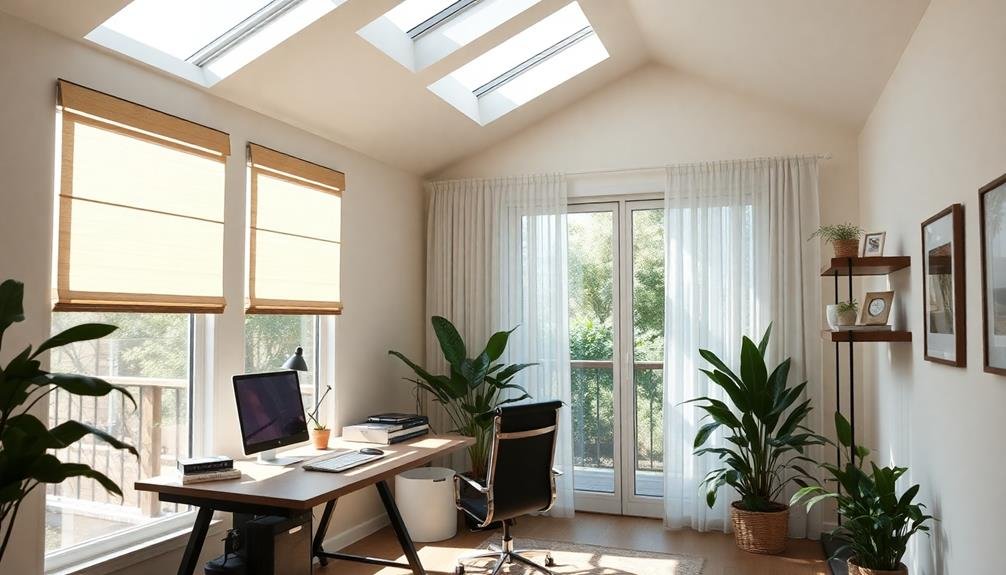
You can maximize your home office's natural light usage with daylight-responsive window treatments.
These smart blinds or curtains automatically adjust throughout the day, optimizing sunlight and reducing glare on your screens.
Positioning your desk to face or be perpendicular to windows will also help you take full advantage of natural light, potentially boosting your productivity and well-being.
Daylight-Responsive Window Treatments
With daylight-responsive window treatments, you'll maximize natural light in your home office while minimizing glare and heat.
These smart window coverings automatically adjust throughout the day, enhancing your workspace's lighting conditions. They use sensors to detect sunlight intensity and angle, then adjust their position accordingly.
You'll benefit from reduced eye strain and improved productivity as these treatments maintain consistent light levels. They'll also help regulate your office's temperature, potentially lowering your energy bills by reducing the need for artificial lighting and air conditioning.
Consider installing motorized blinds or shades that integrate with your smart home system. You can program them to align with your work schedule, ensuring ideal lighting during your most productive hours.
Some advanced systems even learn your preferences over time, fine-tuning their adjustments to your specific needs.
- Feel the comfort of a perfectly lit workspace tailored to your needs
- Experience the satisfaction of effortlessly enhancing your environment
- Enjoy the peace of mind knowing you're reducing your carbon footprint
- Embrace the harmony of technology working seamlessly with nature
Optimal Desk Positioning
Ideal desk positioning plays an essential role in maximizing natural light usage in your home office. To optimize your workspace, place your desk perpendicular to the window, allowing natural light to illuminate your work area without causing glare on your computer screen. This orientation also provides a pleasant view when you look up from your tasks, reducing eye strain and boosting productivity.
Consider the path of sunlight throughout the day when choosing your desk's location. If possible, position it near a north-facing window for consistent, diffused light that won't create harsh shadows or overheat your workspace. For east or west-facing windows, adjust your work schedule to take advantage of morning or afternoon light, respectively.
If you're dealing with limited space or window access, use reflective surfaces like mirrors or light-colored walls to bounce natural light around the room. Additionally, opt for a desk with a light-colored or glossy surface to further enhance light distribution.
Schedule Device Power-Down Times
While optimizing your smart home office, scheduling device power-down times is an essential step in reducing energy consumption and extending equipment lifespan.
Start by identifying devices that can be powered down when not in use, such as printers, monitors, and desktop computers. Set up automatic shutdown schedules for these devices using smart plugs or built-in power management features.
For your computer, configure sleep mode to activate after 15-30 minutes of inactivity. Enable hibernation for longer periods of non-use, like overnight. Don't forget to schedule regular restarts to clear memory and improve performance.
For peripherals like printers and scanners, use smart plugs to cut power completely during non-working hours.
Implementing device power-down times offers numerous benefits:
- Reduced electricity bills, putting more money in your pocket
- Extended device lifespan, saving you from frequent replacements
- Lower carbon footprint, contributing to a greener planet
- Peace of mind knowing you're not wasting energy unnecessarily
Remember to adjust your power-down schedules as your work habits change.
Utilize Occupancy Sensors

In addition to scheduling device power-down times, utilizing occupancy sensors can greatly enhance your smart home office's energy efficiency.
These sensors detect when you're present in your workspace and automatically adjust various systems accordingly. You'll save energy by ensuring lights, heating, cooling, and other devices are only active when you're actually in the room.
Install motion sensors near your desk and entry points to detect movement. Pair them with smart plugs or switches to control lighting and electronics. When you enter, the sensors will trigger the connected devices to turn on. As you leave, they'll power down after a set period of inactivity.
For climate control, use occupancy sensors to adjust your smart thermostat. They'll optimize temperature settings based on your presence, avoiding unnecessary heating or cooling when you're away.
Consider integrating these sensors with your smart home hub for seamless automation. You can create custom routines that respond to your office occupancy, such as turning on your computer and adjusting blinds when you arrive.
Adjust Thermostat for Work Hours
During your work hours, optimizing your smart thermostat settings can greatly reduce energy consumption and maintain a comfortable environment. Program your thermostat to adjust temperatures based on your work schedule, allowing for slight increases during summer and decreases in winter. This approach guarantees you're not wasting energy heating or cooling an empty space when you're away or asleep.
Consider setting your thermostat 7-10 degrees higher in summer and 7-10 degrees lower in winter during non-work hours. When you're working, aim for temperatures around 78°F (26°C) in summer and 68°F (20°C) in winter. These settings strike a balance between comfort and energy efficiency.
Take advantage of your smart thermostat's learning capabilities. Many modern devices can adapt to your habits and preferences over time, automatically adjusting to optimize comfort and energy savings. You can also use your smartphone to control settings remotely, guaranteeing your home office is at the ideal temperature when you start work.
- Feel the satisfaction of lowering your carbon footprint
- Enjoy the comfort of a perfectly climate-controlled workspace
- Experience the relief of reduced energy bills
- Embrace the peace of mind that comes with efficient energy use
Automate Lighting Controls
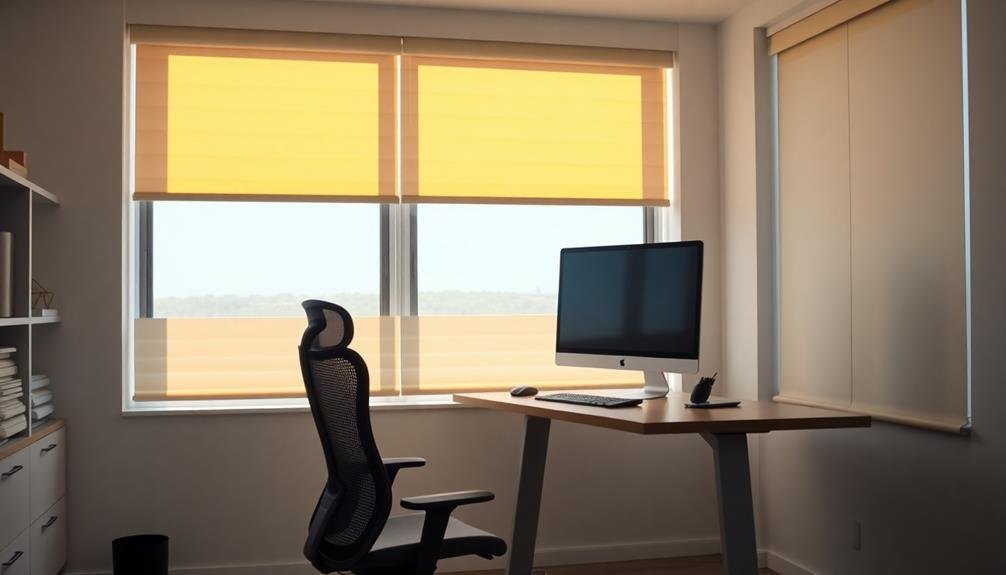
As you set up your smart home office, automating your lighting controls can significantly enhance your productivity and energy efficiency. Start by installing smart bulbs or switches that you can control remotely via smartphone apps or voice commands. These allow you to easily adjust brightness levels and color temperatures throughout the day.
Program your lights to mimic natural daylight cycles, gradually brightening in the morning and dimming in the evening. This helps regulate your circadian rhythm and improves focus during work hours.
Set up motion sensors in less frequently used areas to guarantee lights turn off when you're not present, reducing unnecessary energy consumption.
Create custom lighting scenes for different tasks. For instance, use bright, cool-toned light for high-focus work and softer, warm light for creative tasks or video calls.
Integrate your lighting system with your calendar to automatically adjust based on your daily schedule.
Don't forget about task lighting. Use smart desk lamps that can be programmed to turn on and off at specific times or in response to your work patterns.
This targeted lighting approach reduces eye strain and conserves energy by minimizing the use of overhead lights.
Maximize Energy-Efficient Work Hours
With your smart lighting in place, it's time to focus on when you're most productive. Analyze your work patterns and energy levels throughout the day to identify your peak performance hours. Schedule your most demanding tasks during these times to maximize efficiency and minimize energy waste.
Use your smart home system to create a personalized work schedule that aligns with your natural rhythms. Set up automated reminders to start and end your workday, ensuring you don't burn unnecessary energy by working late. Program your thermostat to adjust temperatures based on your work hours, maintaining comfort while reducing energy consumption during off-hours.
Consider incorporating short breaks and power naps into your schedule to recharge and boost productivity. Use smart plugs to automatically power down non-essential devices during these periods, further reducing energy usage.
- Feel empowered by taking control of your work schedule
- Experience the satisfaction of aligning your productivity with energy efficiency
- Enjoy the peace of mind that comes with knowing you're minimizing waste
- Embrace the sense of accomplishment as you optimize your work-life balance
Monitor and Analyze Energy Consumption
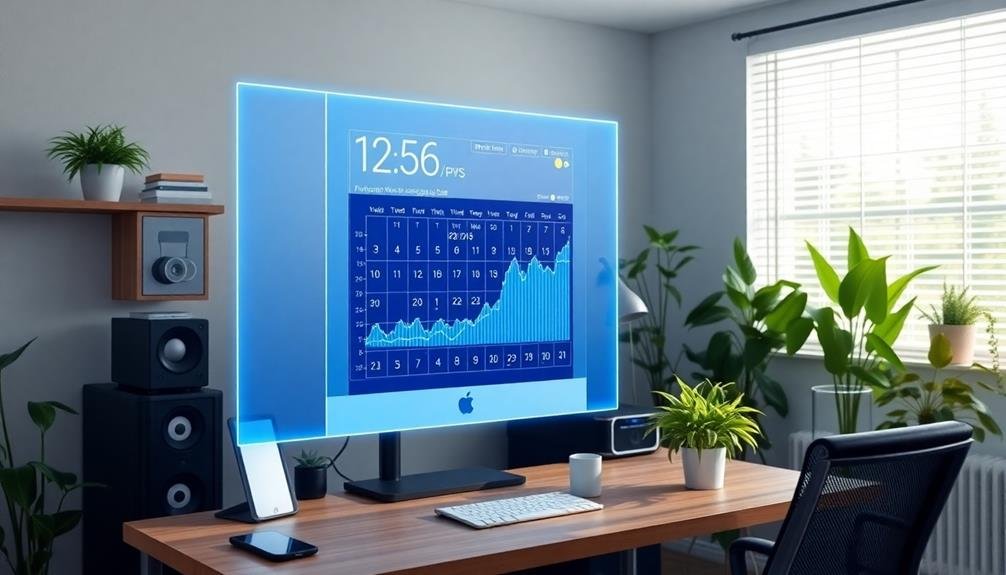
To truly optimize your smart home office's energy efficiency, you'll need to monitor and analyze your energy consumption. Start by installing smart energy meters or plugs that track electricity usage in real-time. These devices will provide detailed insights into which appliances and equipment consume the most power throughout your workday.
Use energy monitoring apps or software to visualize your consumption patterns. Look for trends, such as spikes during certain hours or days of the week. Identify energy-hungry devices and consider replacing them with more efficient alternatives. Pay attention to standby power consumption and unplug devices when they're not in use.
Set up alerts for unusual energy usage patterns, which could indicate malfunctioning equipment or forgotten devices left on. Regularly review your energy reports and adjust your habits accordingly. Compare your consumption data with previous months or seasons to gauge your progress in reducing energy waste.
Consider implementing an energy management system that automatically adjusts your office's power usage based on occupancy and time of day. This can include features like smart thermostats, automated lighting controls, and power management for computers and peripherals.
Frequently Asked Questions
How Do Smart Home Office Schedules Affect Remote Team Collaboration?
Smart home office schedules can enhance your remote team's collaboration by aligning work hours, optimizing meeting times, and ensuring everyone's availability. You'll find it easier to coordinate tasks, share resources, and maintain consistent communication across different time zones.
Can Energy-Saving Schedules Interfere With Software Updates or System Maintenance?
Yes, energy-saving schedules can interfere with updates and maintenance. You'll need to guarantee your devices are active during scheduled updates. It's best to set maintenance windows that don't conflict with your energy-saving times.
What Are the Initial Costs of Implementing a Smart Home Office System?
You'll face initial costs for smart devices, a hub, and installation. Expect to spend $500-$2000, depending on your setup's complexity. Don't forget to factor in potential subscription fees for advanced features or cloud storage.
How Can Energy-Saving Schedules Be Customized for Different Seasons or Climates?
You can customize energy-saving schedules by adjusting thermostat settings, lighting timers, and device usage based on seasonal daylight hours and temperature patterns. You'll also want to take into account local weather trends and your personal comfort preferences for each season.
Are There Any Privacy Concerns With Using Smart Home Office Scheduling Systems?
Yes, you should be aware of privacy concerns. Smart scheduling systems often collect data about your habits and movements. They may be vulnerable to hacking or share your information with third parties. Always review privacy policies before using them.
In Summary
You've now got the tools to transform your home office into an energy-saving powerhouse. By implementing smart scheduling and automation, you'll cut costs and reduce your carbon footprint. Remember, small changes add up. Keep monitoring your energy use and adjusting your strategies. With these tips, you're not just working smarter; you're working greener. Embrace these habits, and you'll see the difference in your energy bills and environmental impact.

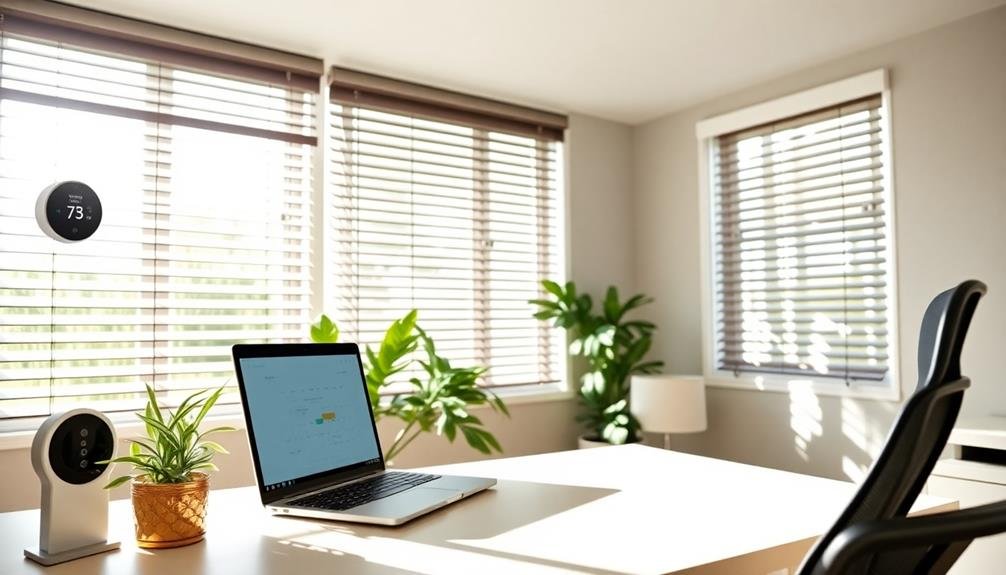
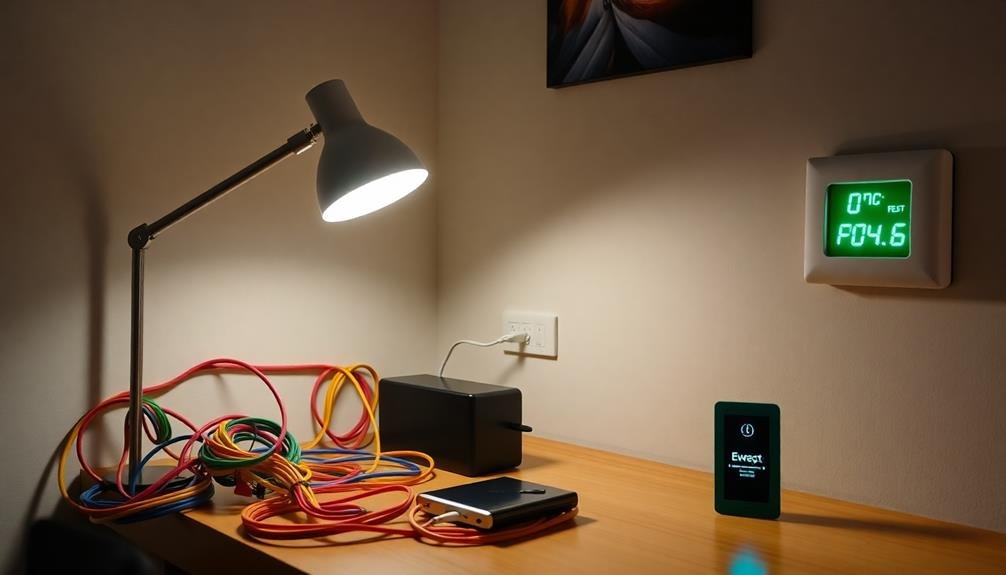
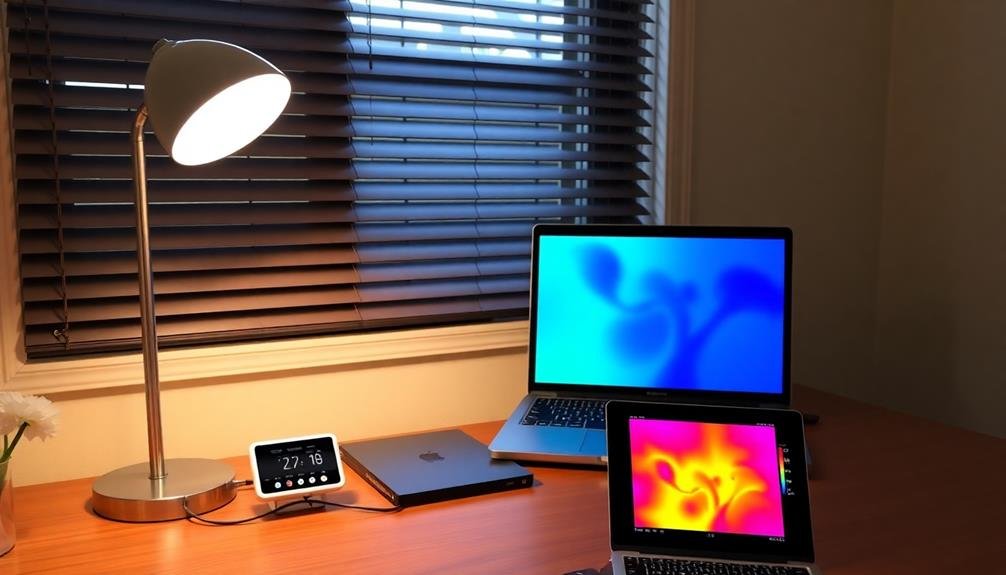
Leave a Reply